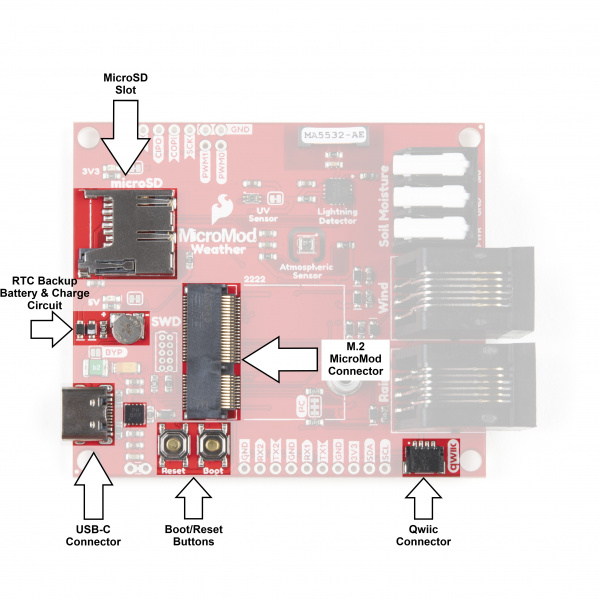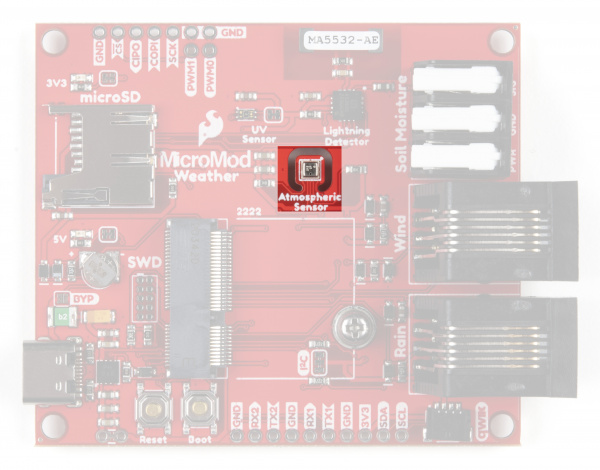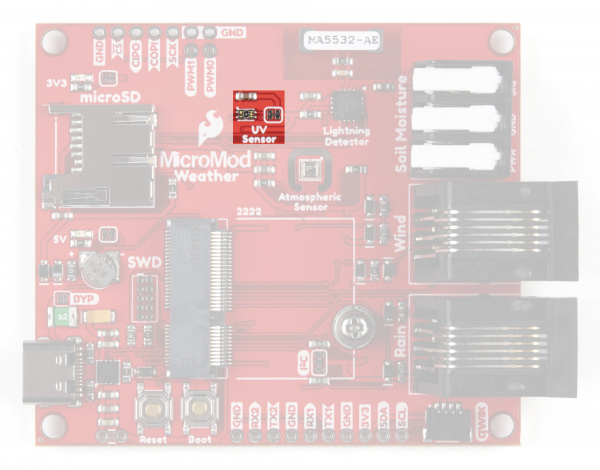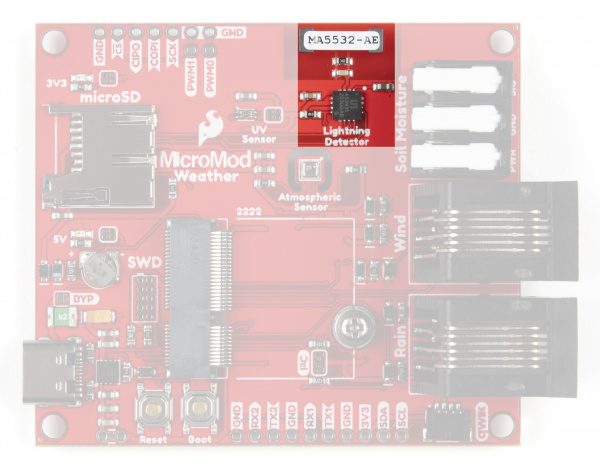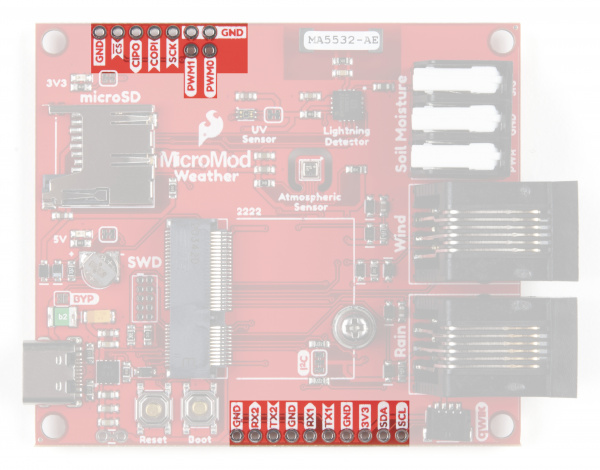MicroMod Weather Carrier Board Hookup Guide
Hardware Overview
In this section we'll cover the various hardware, sensors and adjustable solder jumpers on the MicroMod Weather Carrier Board, the external sensor connections and the pinout of the Carrier Board for a detailed look at how it connects to your chosen MicroMod Processor.
Common Components
Most SparkFun MicroMod Carrier Boards will have some common components and all MicroMod Carrier Boards will have the keyed M.2 MicroMod Connector to plug your processor into. The photo and list below outline some of the components you can expect on the Weather Carrier Board and most other SparkFun MicroMod Carrier Boards.
- M.2 MicroMod Connector - This special keyed M.2 connector lets you install your MicroMod Processor of choice on your Weather Carrier Board.
- USB-C Connector - Connect to your computer to program your processor and also can provide power to your MicroMod system.
- 3.3V Regulator - Provides a regulated 3.3V and sources up to 1A.
- Qwiic Connector - The standard Qwiic connector so you can add other Qwiic devices to your MicroMod system.
- Boot/Reset Buttons - Push buttons to enter boot mode on processors and to reset your MicroMod circuit.
- RTC Backup Battery & Charge Circuit - 1mAh backup battery for the Real-Time Clocks on MicroMod Processors that have a built-in RTC. Receives charge voltage from 3.3V.
- microSD Slot - Insert a microSD card formatted to FAT32 here to log your weather data.
Weather Station Sensors and External Sensor Connections
As we mentioned in the introduction, the board comes with a BME280 Temperature, Pressure and Humidity Sensor, a VEML6075 UV Light Sensor and a AS3935 Lightning Detector. Along with those on board sensors there is a three pin latch terminal for a soil moisture sensor as well as a pair of RJ11 jacks for connecting wind and rain meters.
The three on board sensors paired with the external sensors allows for a powerful and customizable weather tracking tool.
BME280 Temperature, Pressure and Humidity Sensor
The BME280 Atmospheric Sensor from Bosch is the heavy lifter of the Weather Carrier Board. The BME280 is a highly-accurate, digital environmental sensor that measures ambient temperature, relative humidity and barometric pressure.
The BME280 measures humidity from 0 to 100% with an absolute accuracy of ±3 %RH (from 20-80%RH), temperatures between 0°C to 65°C with an absolute accuracy of ±0.5-1.5°C (full temperature range is -40°C to 85°C) and atmospheric pressures between 300 to 1100hPa with an absolute accuracy of ±1hPa (relative accuracy of ±0.12hPa). The I2C address of the BME280 is 0x77.
For detailed information on the sensor's functionality and characteristics, refer to the BME280 Datasheet or our Hookup Guide for the SparkFun Qwiic Atmospheric Sensor (BME280).
VEML6075 UV Sensor
The VEML6075 UV light sensor from Vishay Semiconductors measures UVA (320-400 nm, peak @365 ±10nm ) and UVB (228-320 nm, peak @330 ±10nm) irradiance so you can calculate the UV Index at your Weather Station. Example 4 - Calculate UVI in the SparkFun VEML6075 Arduino Library demonstrates how to calculate that index using this sensor.
The VEML6075 has a UVA resolution of 0.93 counts/µW/cm2 and a UVB resolution of 2.1 counts/µW/cm2. The I2C address is 0x10.
For more information about this UV sensor, refer to the VEML6075 datasheet or our Hookup Guide for the SparkFun Qwiic UV Sensor (VEML6075).
AS3935 Lightning Detector
The AS3935 Lightning Detector from AMS can detect lightning strikes up to 40km away with an accuracy of up to 1km from the storm front. The specially-tuned antenna picks up lightning events in the 500kHz band and a built-in algorithm helps check the incoming signal pattern to reject potential man-made disturbers such as DC/DC converters in large appliances.
The AS3935 Lightning Detector is connected to the primary SPI bus and Chip Select (CS) for the AS3935 is tied to G1/Bus1 (MicroMod pad 42).
For in-depth information about the sensor, refer to the AS3935 Datasheet or our Hookup Guide for the SparkFun Lightning Detector Breakout.
Soil Moisture Sensor Latch Terminal
The three-pin latch terminal makes it easy to connect a Soil Moisture Sensor to your Weather Carrier Board. The soil moisture sensor is a handy addition to the Weather Carrier Board if you are using it in something like a greenhouse environment to keep an eye on your soil and, with some slick coding, you could even turn an irrigation system on or off depending on the sensor's measurements.
The Soil Moisture Sensor has two large coated pads that act as prongs for what is essentially a large variable resistor. The sensor takes advantage of a simple concept of moist soil being more conductive than dry soil so as more water is added to the soil, the resistance of the circuit drops and the SIG output increases.
Power (3.3V) for the sensor is provided by G0 (MicroMod pad 40) allowing you to turn it on and off easily (continuous power is not recommended for the soil moisture sensor) and the Signal output is tied to A0 (MicroMod pad 34).
If you are looking for some inspiration for an automated watering project, check out our Product Showcase Video and the Soil Moisture Sensor Hookup Guide.
Wind and Rain RJ11 Connectors
The two RJ11 connectors allow you to connect the wind and rain sensors included with our Weather Meters Kit to monitor wind speed, wind direction and rainfall. These two sensors are great additions to an outdoor Weather Carrier Board setup to get a more complete view of weather in the area.
The Weather Meters Kit includes an anemometer to measure wind speed, a wind vain to determine wind direction and a self-emptying tipping bucket collector to monitor rainfall. The anemometer outputs a digital signal tied to D0 (MicroMod pad 10). The wind vain outputs an analog signal relative to its position tied to A1 (MicroMod pad 38). The rainfall detector outputs a digital signal to D1 (MicroMod pad 18).
For help assembling and testing your Weather Meters Kit, check out our Weather Meter Hookup Guide.
Plated Through-Hole Headers
The Weather Carrier Board also routes several pins from a connected MicroMod Processor to a pair of plated through-hole (PTH) headers.
On the "North"/Top of the board, the primary SPI bus is routed to a PTH header (the CS pin on this header is routed to G2/BUS2), a trio of Ground pins and both PWM1 & PWM0 if users wish to solder components that can use pulse-width modulation.
The "South"/Bottom of the board features both Serial UARTs (UART1 & UART2), another pair of Ground pins as well as 3.3V and SDA/SCL from the primary I2C bus if users prefer to have a soldered connection for I2C devices instead of the Qwiic connector.
Solder Jumpers
There are a total of seven adjustable solder jumpers on the MicroMod Weather Carrier Board labeled I2C, MEAS, BYP, VE, UV, 5V and 3V3. The table below briefly outlines their functionalities:
| Jumper Name/Label | Description | Default State |
|---|---|---|
| I2C Pull-Up/I2C | Pulls the SDA/SCL lines to 3.3V via two 2.2K Ohm resistors | CLOSED |
| Measure/MEAS | Open this jumper to probe the current draw at the 3.3V output of the regulator. For help measuring current, take a look at our How to Use a Multimeter tutorial. | CLOSED |
| Bypass/BYP | The "penny-in-the-fuse" jumper. Bypasses the 6V/2A fuse and nets VIN and V_USB together. Close only if you know what you are doing! | OPEN |
| Voltage Regulator Enable/VE | Voltage regulator control. Close this jumper to control the VREG in low-power applications. | OPEN |
| UV Sensor Power/UV | Connects VDD of the VEML6075 UV Sensor to 3.3V. Open the jumper to disable power to the UV Sensor. | CLOSED |
| VIN LED Power/VIN LED | Connects the 5V/VIN LED to 5V via a 1K Ohm resistor. Open to disable the LED. | CLOSED |
| 3.3V LED Power/3V3 LED | Connects the 3.3V LED to 3.3V via a 1K Ohm resistor. Open to disable the LED. | CLOSED |
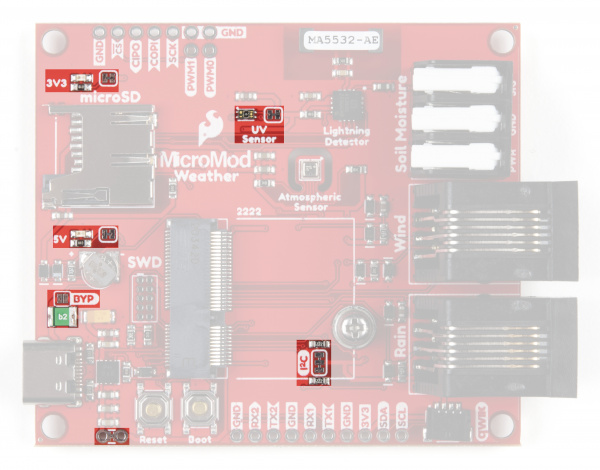 |
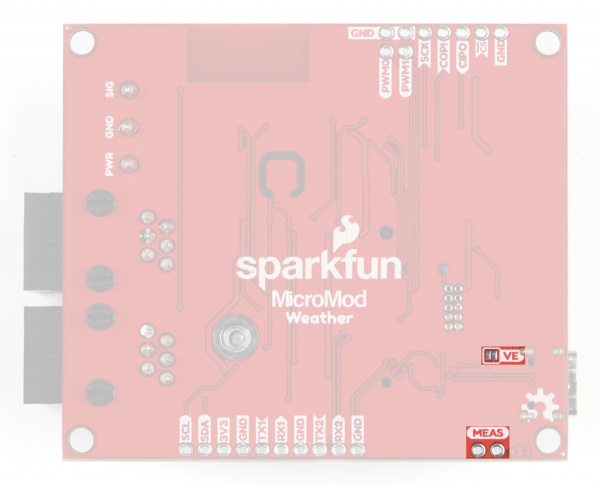 |
MicroMod Pinout
Since this carrier board is designed to work with all of the MicroMod Processors we've included the table below to outline which pins are used so, if you would like, you can compare them to the pinout tables in their respective Hookup Guides.
| AUDIO | UART | GPIO/BUS | I2C | SDIO | SPI | Dedicated |
| M.2 Connector Pin# | MicroMod Pin Name | Weather Station Connection | Description |
|---|---|---|---|
| 1 | GND | GND | Ground plane. |
| 2 | 3.3V | 3.3V | Regulated 3.3V via USB-C. |
| 3 | USB_D+ | Passthrough | USB D+ connection for Processor Board. |
| 4 | 3.3V_EN | 3.3V Enable | Voltage regulator enable input. |
| 5 | USB_D- | Passthrough | USB D- connection for Processor Board. |
| 6 | RESET | RESET Button | Connected to RESET Button. Reset is active LOW |
| 9 | USB_VIN | VIN | Input voltage from USB. |
| 10 | D0 | WSPEED | Digital pin for wind speed. |
| 11 | BOOT | BOOT Button | Connected to BOOT Button. Boot is active LOW. |
| 12 | I2C_SDA | I2C_SDA | I2C data signal for BME280, VEML6075 and other Qwiic/I2C devices. |
| 14 | I2C_SCL | I2C_SCL | I2C clock signal for BME280, VEML6075 and other Qwiic/I2C devices. |
| 17 | UART_TX1 | TX1 | UART1 data output. Tied to TX1 PTH header pin. |
| 18 | D1/CAM_TRIG | RAIN | Digital pin for rain meter signal. |
| 19 | UART_RX1 | RX1 | UART1 data input. Tied to RX1 PTH header pin. |
| 20 | UART_RX2 | RX2 | UART2 data input. Tied to RX2 PTH header pin. |
| 21 | SWDCK | SWDCK | Serial Wire Debug Clock. |
| 22 | UART_TX2 | TX2 | UART2 data output. Tied to TX2 PTH header pin. |
| 23 | SWDIO | SWDIO | Serial Wire Debug I/O |
| 32 | PWM0 | PWM0 | Dedicated PWM0 pin. Broken out to PTH header pin. |
| 34 | A0 | SOIL_MOIST_SIG | Analog input from soil mositure sensor. |
| 38 | A1 | WDIR | Analog input for wind direction. |
| 40 | G0/BUS0 | SOIL_MOIST_PWR | General purpose pin configured for 3.3V output. |
| 42 | G1/BUS1 | LIGHTNING_CS | AS3935 Chip Select. |
| 44 | G2/BUS2 | HEADER_CS | General chip select pin. Tied to SPI PTH header. |
| 46 | G3/BUS3 | LIGHTNING_INT | AS3935 interrupt pin. |
| 47 | PWM1 | PWM1 | Dedicated PWM1 pin. Broken out to PTH header pin. |
| 49 | BATT_VIN/3 | VIN/3 | Divided input voltage for monitoring power supply. |
| 55 | SPI_CS | SD_CS | µSD Chip Select. |
| 57 | SPI_SCK | SPI_SCK | SPI clock signal. |
| 59 | SPI_COPI | SPI_COPI | SPI Controller Out/Peripheral In signal. |
| 61 | SPI_CIPO | SPI_CIPO | SPI Controller In/Peripheral Out signal. |
| 72 | RTC_3V | RTC_3V | 3V output for backup battery charging. |
| Function | Bottom Pin |
Top Pin |
Function | ||||||
|---|---|---|---|---|---|---|---|---|---|
| (Not Connected) | 75 | GND | |||||||
| 3.3V | 74 | 73 | G5 / BUS5 | ||||||
| RTC_3V_BATT | 72 | 71 | G6 / BUS6 | ||||||
| SPI_CS1# | SDIO_DATA3 (I/O) | 70 | 69 | G7 / BUS7 | |||||
| SDIO_DATA2 (I/O) | 68 | 67 | G8 | ||||||
| SDIO_DATA1 (I/O) | 66 | 65 | G9 | ADC_D- | CAM_HSYNC | ||||
| SPI_CIPO1 | SDIO_DATA0 (I/O) | 64 | 63 | G10 | ADC_D+ | CAM_VSYNC | |||
| SPI COPI1 | SDIO_CMD (I/O) | 62 | 61 | SPI_CIPO (I) | |||||
| SPI SCK1 | SDIO_SCK (O) | 60 | 59 | SPI_COPI (O) | LED_DAT | ||||
| AUD_MCLK (O) | 58 | 57 | SPI_SCK (O) | LED_CLK | |||||
| CAM_MCLK | PCM_OUT | I2S_OUT | AUD_OUT | 56 | 55 | SPI_CS# | |||
| CAM_PCLK | PCM_IN | I2S_IN | AUD_IN | 54 | 53 | I2C_SCL1 (I/O) | |||
| PDM_DATA | PCM_SYNC | I2S_WS | AUD_LRCLK | 52 | 51 | I2C_SDA1 (I/O) | |||
| PDM_CLK | PCM_CLK | I2S_SCK | AUD_BCLK | 50 | 49 | BATT_VIN / 3 (I - ADC) (0 to 3.3V) | |||
| G4 / BUS4 | 48 | 47 | PWM1 | ||||||
| G3 / BUS3 | 46 | 45 | GND | ||||||
| G2 / BUS2 | 44 | 43 | CAN_TX | ||||||
| G1 / BUS1 | 42 | 41 | CAN_RX | ||||||
| G0 / BUS0 | 40 | 39 | GND | ||||||
| A1 | 38 | 37 | USBHOST_D- | ||||||
| GND | 36 | 35 | USBHOST_D+ | ||||||
| A0 | 34 | 33 | GND | ||||||
| PWM0 | 32 | 31 | Module Key | ||||||
| Module Key | 30 | 29 | Module Key | ||||||
| Module Key | 28 | 27 | Module Key | ||||||
| Module Key | 26 | 25 | Module Key | ||||||
| Module Key | 24 | 23 | SWDIO | ||||||
| UART_TX2 (O) | 22 | 21 | SWDCK | ||||||
| UART_RX2 (I) | 20 | 19 | UART_RX1 (I) | ||||||
| CAM_TRIG | D1 | 18 | 17 | UART_TX1 (0) | |||||
| I2C_INT# | 16 | 15 | UART_CTS1 (I) | ||||||
| I2C_SCL (I/0) | 14 | 13 | UART_RTS1 (O) | ||||||
| I2C_SDA (I/0) | 12 | 11 | BOOT (I - Open Drain) | ||||||
| D0 | 10 | 9 | USB_VIN | ||||||
| SWO | G11 | 8 | 7 | GND | |||||
| RESET# (I - Open Drain) | 6 | 5 | USB_D- | ||||||
| 3.3V_EN | 4 | 3 | USB_D+ | ||||||
| 3.3V | 2 | 1 | GND | ||||||
| Signal Group | Signal | I/O | Description | Voltage | Power | 3.3V | I | 3.3V Source | 3.3V |
|---|---|---|---|---|
| GND | Return current path | 0V | ||
| USB_VIN | I | USB VIN compliant to USB 2.0 specification. Connect to pins on Processor Board that require 5V for USB functionality | 4.8-5.2V | |
| RTC_3V_BATT | I | 3V provided by external coin cell or mini battery. Max draw=100μA. Connect to pins maintaining an RTC during power loss. Can be left NC. | 3V | |
| 3.3V_EN | O | Controls the carrier board's main voltage regulator. Voltage above 1V will enable 3.3V power path. | 3.3V | |
| BATT_VIN/3 | I | Carrier board raw voltage over 3. 1/3 resistor divider is implemented on carrier board. Amplify the analog signal as needed for full 0-3.3V range | 3.3V | |
| Reset | Reset | I | Input to processor. Open drain with pullup on processor board. Pulling low resets processor. | 3.3V |
| Boot | I | Input to processor. Open drain with pullup on processor board. Pulling low puts processor into special boot mode. Can be left NC. | 3.3V | |
| USB | USB_D± | I/O | USB Data ±. Differential serial data interface compliant to USB 2.0 specification. If UART is required for programming, USB± must be routed to a USB-to-serial conversion IC on the processor board. | |
| USB Host | USBHOST_D± | I/O | For processors that support USB Host Mode. USB Data±. Differential serial data interface compliant to USB 2.0 specification. Can be left NC. | |
| CAN | CAN_RX | I | CAN Bus receive data. | 3.3V |
| CAN_TX | O | CAN Bus transmit data. | 3.3V | |
| UART | UART_RX1 | I | UART receive data. | 3.3V |
| UART_TX1 | O | UART transmit data. | 3.3V | |
| UART_RTS1 | O | UART request to send. | 3.3V | |
| UART_CTS1 | I | UART clear to send. | 3.3V | |
| UART_RX2 | I | 2nd UART receive data. | 3.3V | |
| UART_TX2 | O | 2nd UART transmit data. | 3.3V | |
| I2C | I2C_SCL | I/O | I2C clock. Open drain with pullup on carrier board. | 3.3V |
| I2C_SDA | I/O | I2C data. Open drain with pullup on carrier board | 3.3V | |
| I2C_INT# | I | Interrupt notification from carrier board to processor. Open drain with pullup on carrier board. Active LOW | 3.3V | |
| I2C_SCL1 | I/O | 2nd I2C clock. Open drain with pullup on carrier board. | 3.3V | |
| I2C_SDA1 | I/O | 2nd I2C data. Open drain with pullup on carrier board. | 3.3V | |
| SPI | SPI_COPI | O | SPI Controller Output/Peripheral Input. | 3.3V |
| SPI_CIPO | I | SPI Controller Input/Peripheral Output. | 3.3V | |
| SPI_SCK | O | SPI Clock. | 3.3V | |
| SPI_CS# | O | SPI Chip Select. Active LOW. Can be routed to GPIO if hardware CS is unused. | 3.3V | |
| SPI/SDIO | SPI_SCK1/SDIO_CLK | O | 2nd SPI Clock. Secondary use is SDIO Clock. | 3.3V |
| SPI_COPI1/SDIO_CMD | I/O | 2nd SPI Controller Output/Peripheral Input. Secondary use is SDIO command interface. | 3.3V | |
| SPI_CIPO1/SDIO_DATA0 | I/O | 2nd SPI Peripheral Input/Controller Output. Secondary use is SDIO data exchange bit 0. | 3.3V | |
| SDIO_DATA1 | I/O | SDIO data exchange bit 1. | 3.3V | |
| SDIO_DATA2 | I/O | SDIO data exchange bit 2. | 3.3V | |
| SPI_CS1/SDIO_DATA3 | I/O | 2nd SPI Chip Select. Secondary use is SDIO data exchange bit 3. | 3.3V | |
| Audio | AUD_MCLK | O | Audio master clock. | 3.3V |
| AUD_OUT/PCM_OUT/I2S_OUT/CAM_MCLK | O | Audio data output. PCM synchronous data output. I2S serial data out. Camera master clock. | 3.3V | |
| AUD_IN/PCM_IN/I2S_IN/CAM_PCLK | I | Audio data input. PCM syncrhonous data input. I2S serial data in. Camera periphperal clock. | 3.3V | |
| AUD_LRCLK/PCM_SYNC/I2S_WS/PDM_DATA | I/O | Audio left/right clock. PCM syncrhonous data SYNC. I2S word select. PDM data. | 3.3V | |
| AUD_BCLK/PCM_CLK/I2S_CLK/PDM_CLK | O | Audio bit clock. PCM clock. I2S continuous serial clock. PDM clock. | 3.3V | |
| SWD | SWDIO | I/O | Serial Wire Debug I/O. Connect if processor board supports SWD. Can be left NC. | 3.3V |
| SWDCK | I | Serial Wire Debug clock. Connect if processor board supports SWD. Can be left NC. | 3.3V | |
| ADC | A0 | I | Analog to digital converter 0. Amplify the analog signal as needed to enable full 0-3.3V range. | 3.3V |
| A1 | I | Analog to digital converter 1. Amplify the analog signal as needed to enable full 0-3.3V range. | 3.3V | |
| PWM | PWM0 | O | Pulse width modulated output 0. | 3.3V |
| PWM1 | O | Pulse width modulated output 1. | 3.3V | |
| Digital | D0 | I/O | General digital input/output pin. | 3.3V |
| D1/CAM_TRIG | I/O | General digital input/output pin. Camera trigger. | 3.3V | |
| General/Bus | G0/BUS0 | I/O | General purpose pins. Any unused processor pins should be assigned to Gx with ADC + PWM capable pins given priority (0, 1, 2, etc.) positions. The intent is to guarantee PWM, ADC and Digital Pin functionality on respective ADC/PWM/Digital pins. Gx pins do not guarantee ADC/PWM function. Alternative use is pins can support a fast read/write 8-bit or 4-bit wide bus. | 3.3V |
| G1/BUS1 | I/O | 3.3V | ||
| G2/BUS2 | I/O | 3.3V | ||
| G3/BUS3 | I/O | 3.3V | ||
| G4/BUS4 | I/O | 3.3V | ||
| G5/BUS5 | I/O | 3.3V | ||
| G6/BUS6 | I/O | 3.3V | ||
| G7/BUS7 | I/O | 3.3V | ||
| G8 | I/O | General purpose pin | 3.3V | |
| G9/ADC_D-/CAM_HSYNC | I/O | Differential ADC input if available. Camera horizontal sync. | 3.3V | |
| G10/ADC_D+/CAM_VSYNC | I/O | Differential ADC input if available. Camera vertical sync. | 3.3V | |
| G11/SWO | I/O | General purpose pin. Serial Wire Output | 3.3V |
Board Dimensions
The Weather Carrier Board measures 2.65" x 2.30" (67.31mm x 58.42mm) and has four mounting holes that fit a standard 4-40 screw.
